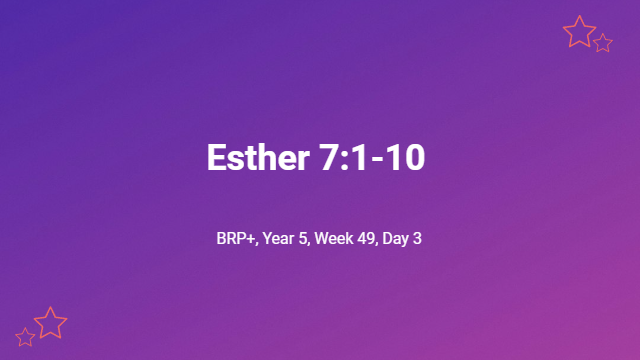Esther 7:1-10
Q.1. Was the king favourable toward Esther? How did she approach him? How courageous was her appeal? Was the king aware of Haman’s plot? – (Esth.7:1-6 c.f. Esth.3:7-15)
Upon learning about the edict to exterminate all Jews in the kingdom, Esther had called on her people to fast and pray (Est.4:15-17). She had asked Ahasuerus and Haman for a banquet. The king had picked up that something was troubling the queen (Esth.5:3). At this second banquet, he had again shown that he wanted to please her – … “What is your petition, Queen Esther? It shall be granted you. And what is your request? Even to half of the kingdom it shall be done.” (Esth.7:2). With great respect and courage, she presented her request – 3 … “If I have found favour in your sight, O king, and if it pleases the king, let my life be given me as my petition, and my people as my request; 4 for we have been sold, I and my people, to be destroyed, to be killed and to be annihilated. Now if we had only been sold as slaves, men and women, I would have remained silent, for the trouble would not be commensurate with the annoyance to the king.” (Esth.7:3-4). He was shocked, and – Then King Ahasuerus asked Queen Esther, “Who is he, and where is he, who would presume to do such a thing?” (Esth.7:5). We must understand the deceit of Haman. The king had to rule over one hundred and twenty-seven provinces and was extremely busy (Esth.1:1). Haman had indeed told the king about people scattered throughout his kingdom, whose – laws are different … and they do not observe the king’s laws, so it is not in the king’s interest to let them remain (Est.3:8-9). He had not identified them as Jews who had blessed the realm during the time of the prophet Daniel. He had even been willing to pay ten thousand talents of silver to carry out the edict. The king didn’t need the money. He – … took his signet ring from his hand and gave it to Haman, the son of Hammedatha the Agagite, the enemy of the Jews (Esth.3:10). The edict was then written as Haman had commanded and sealed with the king’s signet ring by Haman (Esth.3:12). Esther then courageously spelled out the problem – … A foe and an enemy is this wicked Haman! (Esth.7:6).
Q.2. What made the king retreat to the palace garden? How did he interpret Haman’s appeal to Esther? What information led to Haman’s hanging? – (Esth.7:7-10)
Up until this time, Ahasuerus had considered Haman a trusted friend. As the truth dawned, he retreated to the palace garden to contemplate on what to do. Haman came far too close to Esther, begging for his life (Esth.7:7). Upon his return the king saw – … Haman was falling on the couch where Esther was. Then the king said, “Will he even assault the queen with me in the house?” As the word went out of the king’s mouth, they covered Haman’s face (Esth.7:8). Just then one of the king’s eunuch’s reported – … “Behold indeed, the gallows standing at Haman’s house fifty cubits high, which Haman made for Mordecai who spoke good on behalf of the king!” And the king said, “Hang him on it.” (Esth.7:9). The king had felt used and abused by Haman. Haman’s removal brought an end to his anger (Esth.7:10). Prayers had been answered and hope was restored to the Jews.

